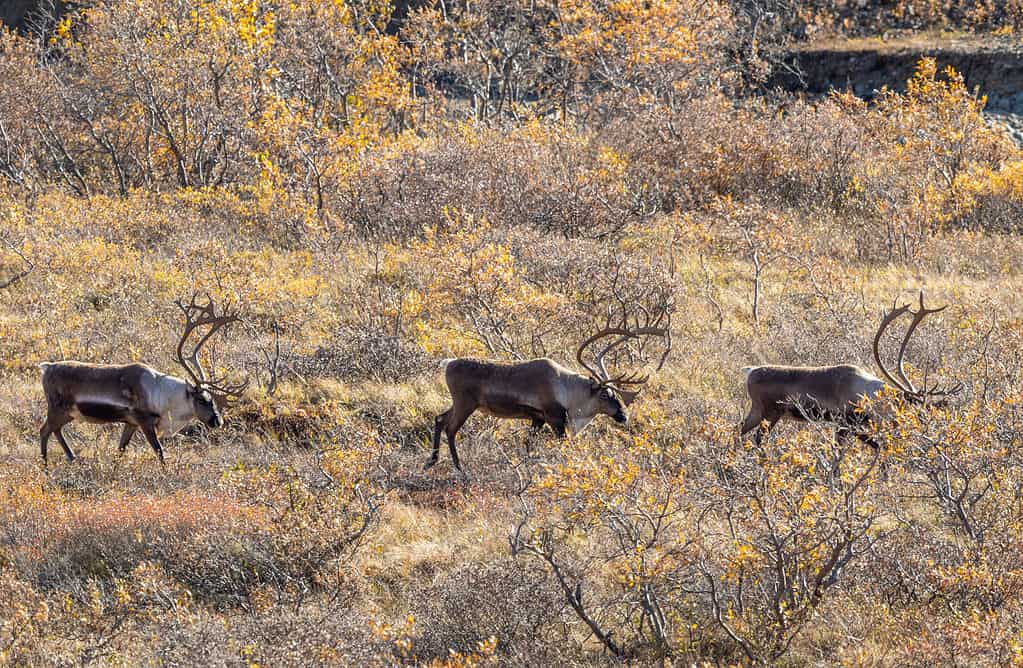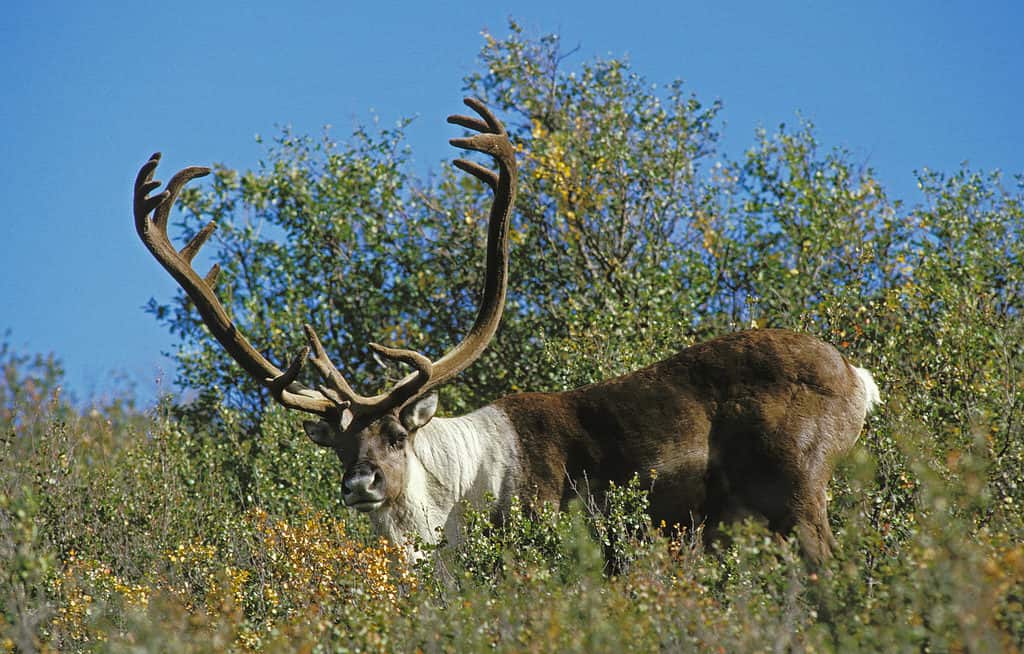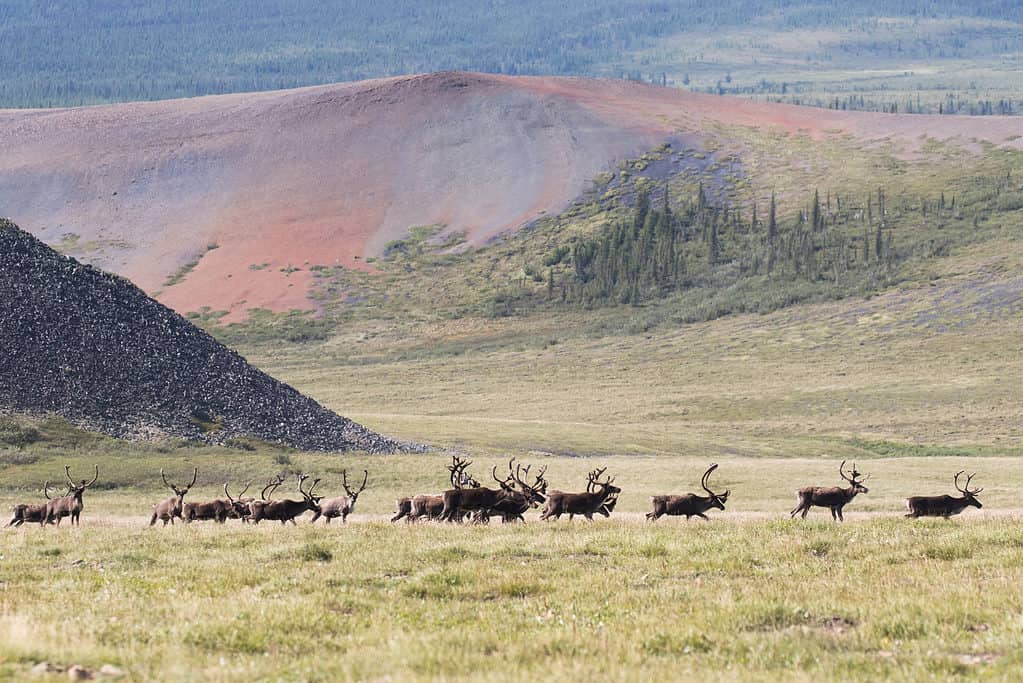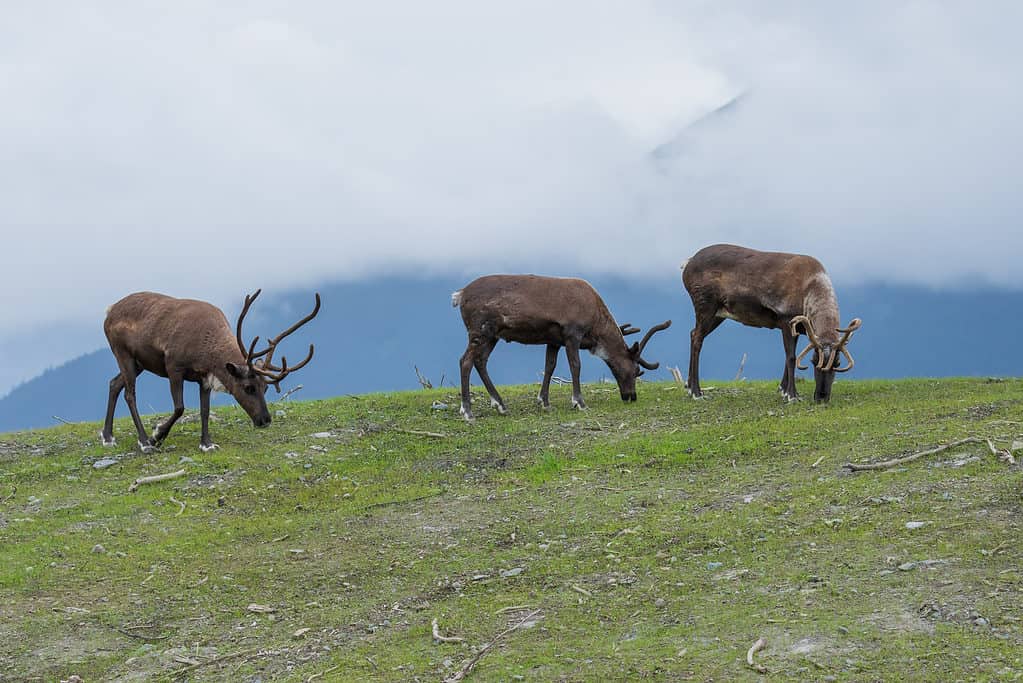Barren-ground caribou are a subspecies of reindeer. They are bigger than the Peary, union, and dolphin caribou. The average weight of the bull is 220 to 309 pounds, and the adult females weigh 187 pounds.
Barren-ground caribou experience long migrations and often travel in large groups of hundreds or thousands. Their migration herds have names that come from the traditional calving grounds. They include:
- The Bathurst herd
- The Porcupine herd
- Bluenose East and West herd
- Baffin Island herds
Today, we discover the largest barren-ground caribou ever caught in Alaska. We also explore the animal’s adaptations, annual cycle, threats, importance to the ecosystem, and possible measures to save it.

Barren-ground
caribou
are a subspecies of reindeer and have adapted to survive in their harsh environment.
©Tom Tietz/Shutterstock.com
The Largest Barren-Ground Caribou Ever Caught in Alaska
Daniel L. Dobbs caught the biggest barren-ground caribou in Alaska and the world in 1999. He killed the bull in Iliamna Lake in Alaska. The largest barren-ground caribou boasts a score of 477 in the Boone and Crockett book.

The largest barren-ground caribou caught in Alaska scored 477 in the Boone and Crockett book.
©iStock.com/slowmotiongli
Where is Iliamna Lake Located on a Map?
Iliamna Lake is a large freshwater lake in Alaska, covering an area of approximately 1,150 square miles. Situated in the southwestern part of the state, it lies within the boundaries of the Lake and Peninsula Borough. The lake is surrounded by rugged mountains and rolling hills that create a breathtaking landscape.
Getting to Iliamna Lake can be quite challenging due to its remote location. There are no roads leading directly to the lake, so visitors must rely on alternative means of transportation, such as boats or planes. Most people arrive at nearby villages like Igiugig or Newhalen before taking a smaller plane or boat to reach their final destination at Iliamna Lake.
Overall, visiting Iliamna Lake promises an unforgettable adventure filled with stunning scenery and unique wildlife sightings that make it well worth any effort required to get there.
Adaptations of Barren-Ground Caribou
Barren-ground caribou have powerful adaptations to survive in their environment. They include:
Split Hooves
The barren-ground caribou’s hooves are split like a cow’s. This allows them to carry their heavy weight without sinking because the hooves are also spread apart.
Seasonally, the hooves change their shape. During summer, the fleshy pad between the hooves grows thicker. But in the winter, the pad retreats have dense hairs to protect the caribou from the cold while offering the animal better traction on the snow.
Thick Fur
Caribou’s body has double layers of fur. The inner coat holds air and keeps the animals dry whenever they cross a river. The outer coat’s hairs are hollow and packed with air. The trapped air insulates the caribou’s body against heat loss and ensures buoyancy when they swim.
A Specialized Digestive System
Caribou are ruminants with a complex digestive system that enables them to survive on vegetation like lichen (their primary diet during winter). Although lichen has low nutrients, it grows in huge quantities on rocks, sand, and trees, providing food during scarcity.
The guts of caribou have certain bacteria that help them digest every nutrient possible in lichen. Their ability to survive on low-nutrient foods is a special adaptation these animals possess to thrive during winter.
Compact and Stocky Body
The body of the caribou is compact and stocky. They have short tails and ears to prevent them from losing heat. Their long skinny legs are packed with veins and arteries running close together to allow the arterial blood’s heat to warm the cooler blood from the lower legs.
Their nostrils have fine hairs to warm the cold air before they inhale it in their lungs.
Barren-Ground Caribou’s Annual Cycle
March and April are when barren-ground caribou migrate from the northward wintering areas to their calving grounds. These grounds can be over 435 miles away and are always located in high rocky places with little shelter from the wind and snow. During all this time, the bulls and the offspring do not reach the calving grounds.
Most pregnant cows deliver in the first weeks of June when the temperatures almost reach freezing. However, the calves are strong enough to follow their mother one hour after birth.
After calving, females and their offspring start trekking back toward the winter range. Then, as the summer approaches, the cows meet with the bulls in the north.
Mosquitoes and nose-bot disturbances cause barren-ground caribou to form post-calving aggregations. These aggregations can be in hundreds of animals.
Insect disturbance declines in August and September, allowing the caribou to focus on feeding comfortably. They will eat lichens, mushrooms, grasses, and shrubs. Eventually, the animals will break into smaller herds as they move across the tundra.
Rutting happens in October and may last for two to three weeks. During winter, the distribution of the barren-ground caribou will face changes since the herds are looking for locations with abundant food and shallow snow. When spring falls, the animals will again start migrating toward the calving grounds.

Barren-ground caribou experience long migrations and often travel in large groups of hundreds or thousands.
©Jukka Jantunen/Shutterstock.com
Threats Facing Barren-Ground Caribou
Barren-ground caribou face various threats, including:
Insect Harassment
This is the primary threat to barren-ground caribou. In addition, caribou are prey species that live in large herds, which makes them susceptible to insect harassment.
Insect harassment occurs when insects swarm around the caribou, biting and stinging them. The most common insects that harass caribou are mosquitoes, black flies, and deer flies. Unfortunately, caribou are also vulnerable to insect injuries, such as eye injuries from deer flies. These injuries can cause blindness in calves and adults.
Habitat Loss
Caribou need habitats for foraging, depending on the animal’s annual breeding cycle. As generalist foragers, barren-ground caribou will obtain nutrients from plants like sedges, grasses, and shrubs.
To survive, caribou need ample space that will accommodate changes in parasite risks, plant growth, predation, and snow cover over the year. During summer, caribou search for habitats less exposed to insect harassment with top-notch forage.
The reduction of habitats due to forest fires and increasing infrastructure has led to a decline in the caribou population. In Alaska, industrial development activities are destroying caribou’s habitats. These activities include:
- Mining
- Oil and gas extraction
- Road building
Climate Change
In 2004, Canada’s Species at Risk Act declared barren-ground caribou a “Special Concern” due to the negative effects of climate change. Climate change impacts include ice loss and melting, vegetation changes, and permafrost thawing. These changes have implications for both caribou habitats and the availability of their food sources.
Caribou depend on Arctic tundra for survival in winter, but climate change is causing the tundra to change rapidly. The Arctic is warming twice as fast as the rest of the planet, making it one of Earth’s most rapidly changing regions. In Canada’s north, this means warmer and shorter winters with less snow cover (the white blanket that insulates the ground and provides animal food).
Caribou are also affected by changes in weather patterns that affect where they can find food in winter months when they travel to their calving grounds. Caribou are a keystone species whose health affects other species, such as birds, mammals, insects, and trees. This is because they provide food and shelter for many species during critical times of the year when resources are scarce elsewhere in the ecosystem.
Overgrazing in the Calving Grounds
Barren-grounds’ calving grounds are vital to their survival and breeding patterns. During this time, they will gather together at one location and calve their young. While this is a good environment for the calves, it also makes them susceptible to predators such as wolves, grizzly bears, and polar bears. If the predator gets too close to the herd, it could cause problems for the herd’s survival rate.
Overgrazing of caribou calving grounds by domestic animals can be a problem. When large domestic animals graze in the same area over a short period, they can destroy vegetation and erode soils. This destroys important habitats for caribou, who depend on these areas for shelter and food during their migration.
Predation by Wolves
Wolves are known to prey on barren-ground caribou. In some areas, wolves have been observed killing caribou calves that are too young to keep up with their mothers in flight. This is particularly true during severe winters when forage is scarce, and caribou calves can’t keep up with their mothers’ fast pace.
Wolves also prey on adult barren-ground caribou under certain circumstances. For example, wolves may attack an isolated adult caribou separated from a herd during the winter when food resources are scarce.
Parasites and Diseases
Barren-ground caribou are threatened by diseases such as foot and mouth and parasitic worms such as lungworms and liver fluke.
Foot and mouth disease is caused by a virus that can infect all cloven-hoofed animals. It is spread through contact with infected animals or bodily fluids, contaminated equipment or vehicles, and feedstuffs. It can also be carried in the wind over long distances.
When an animal contracts foot and mouth disease, it will exhibit blisters in its mouth, feet, and teats. It may also experience high fever and diarrhea.
Parasitic worms such as lungworm or liver fluke can infect caribou populations when they eat infected vegetation or other animals carrying parasites. The parasites can cause damage to their lungs, gut, and liver, which leads to death if left untreated.
Barren-Ground Caribou’s Importance to the Ecosystem
Caribou are a keystone species that strongly impact their environment and the food chain they are part of. Their critical role in the ecosystem is such that if they do not exist, there would be no one to eat the plants that they feed on. Similarly, the predator animals that live off them would also be severely affected.
Caribou keep the vegetation short through grazing and trampling. They also transport nutrients from one area to another when they migrate between summer and winter habitats. This helps maintain a healthy environment within their range, which benefits everyone else who lives there as well!
Caribou also shape the Arctic landscape by creating trails allowing other animals to pass through areas without roads or paths. In addition, the tracks that caribou make on their seasonal migrations provide access for hunters, trappers, and hikers who follow them across the landscape during their travels.

Barren-ground caribou keep the vegetation short through grazing and trampling.
©Tom Tietz/Shutterstock.com
Measures to Conserve Barren-Ground Caribou
Barren-grounds are essential to the Arctic ecosystem, yet their population has declined in recent decades. To prevent further decline and preserve this unique species, there are several measures that conservationists have taken.
One measure is protecting their habitat from human interference. This includes preventing human development where the animals live and avoiding activities that could disturb them or their habitat.
Another measure is breeding programs for captive herds. Captive herds help repopulate areas where there are few or no other caribou left due to hunting or other factors. Using these captive herds can help keep the species alive when numbers drop too low for natural reproduction without human intervention.
Also, organizations should increase awareness about this animal’s status and how to protect it — both among scientists and the general public. People need to know what they can do to help these animals survive!
Finally, preserve these animals’ genetic diversity by maintaining different varieties of populations. As a result, they won’t inbreed over time and lose some of the adaptations that make them resilient creatures capable of surviving so well in harsh conditions.
Final Thoughts
Working together, we can restore and improve the habitat for barren-ground caribou to increase their food supply and provide more space for these animals to live. However, since the caribou cannot realistically be brought back to the herds that have been lost, it is up to government agencies and organizations to take responsibility and ensure they can flourish.
The restoration of the habitat will provide the perfect opportunity to not only keep caribou alive but also flourish. Together, they can create a ground-breaking balance between predators and prey, resulting in a thriving ecosystem where all animals, including man, can live peacefully.
The photo featured at the top of this post is © Alamin-Khan/Shutterstock.com
Thank you for reading! Have some feedback for us? Contact the AZ Animals editorial team.







